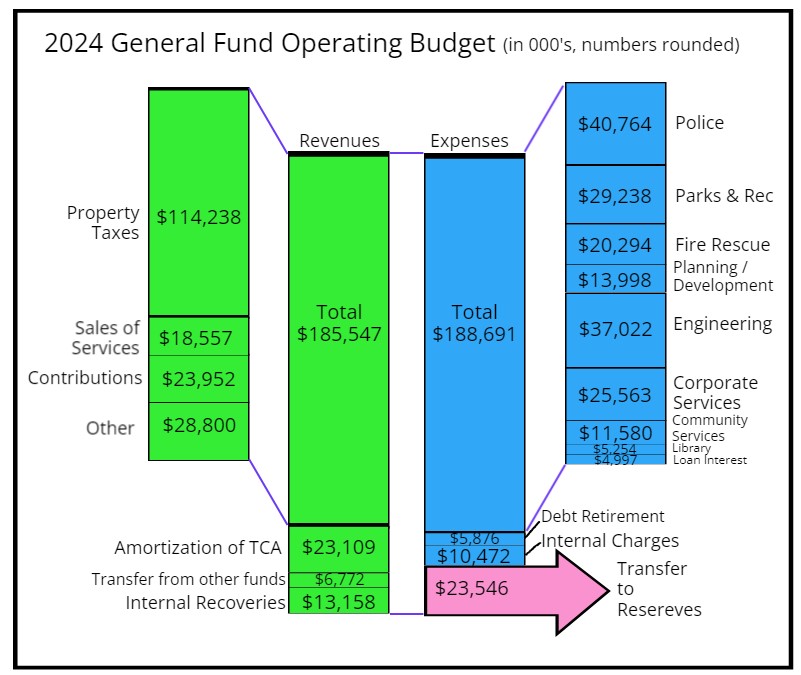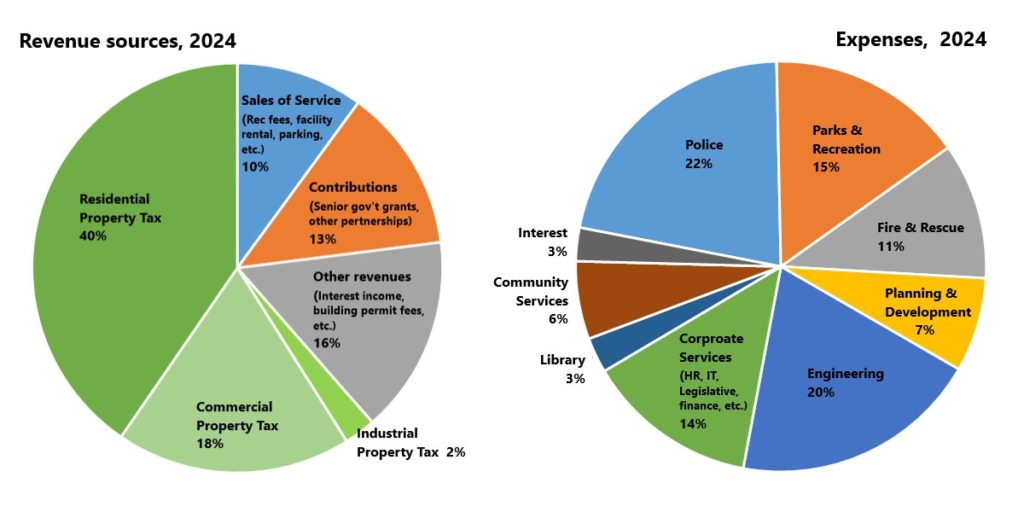Back at it after Spring Break and Easter and all of those things, we had a full agenda on Monday, but got through it pretty quickly, partly because we got through this many things On Consent:
Active Rehabilitation Lease Agreement at 65 E. Sixth Avenue (təməsew̓txʷ Aquatic and Community Centre)
Part of the new TACC is a lease space for a commercial physiotherapy business. This is not uncommon in community recreation centres, drives a bit of revenue for the City, and provides a service for the community. The City is regulated in its interactions with private business, so we did a public call for proposals, and staff selected a successful lessee for the spot. This is the real estate agreement, with rates aligned with industry (and a little bit higher than we anticipated in the early part of the term, indicating we had a motivated lessee), and the tenant paying for fitting out of the site. This is a 5 year lease with an option to extend for a second 5 year term. Getting excited about getting this place open!
Appointment of Corporate Officer
The Corporate Officer is a legislated position in the City that has some very strictly defined legal authorities. Our previous CO was “scooped” by another local government last year, and we spent some time doing a proper regional search during which time we had a couple of experienced Interim COs to cover off. We are now appointing a new CO with significant experience that we “scooped” form another local government, as is the nature of the industry right now. So you will note a new person sitting to my right during Council Meetings, and helping guide me through Roberts Rules and the Procedures Bylaw, along with doing many statutory duties that fall on the CO. Welcome, Hanieh!
Construction Noise Bylaw Exemption Request: 230 Keary Street
The last building at the Brewery District is a hole in the ground, and they are going to put a tower in, which for traffic disturbance reasons is better to happen on the weekend in this location, which requires a Construction Noise Bylaw exemption.
Crises Response Pilot Project Update
This is an update on the implementation of the Crisis Response Pilot Project. I don’t need to delve too deep into what this is, you can read about when we approved it here, and get more details on the City website here. Staff are also doing outreach to the Downtown Residents Association and the downtown businesses about this, and I have had a few very good meetings of late with downtown businesses about their experiences, and ways we can assure this response makes visible change to their situation. The big take-away is that the community supports this approach and this work. I am still chagrinned that some on Council would rather make political hay about the challenges facing downtown businesses instead of voting to support the work to address these challenges, but that’s the situation we are in.
Part of the commitment we made to the community is to report out on this pilot on a regular basis, and this is that report. As this program is just being launched (we had to approve budget, then do some hiring and training to set the program up, so it will not be fully implemented until the summer) so this is more a report about the progress on setting up than on the results. We are also receiving great support from Fraser Health and other partner agencies. More to come!
Metro 2050 Amendment Application: City of Maple Ridge
This is inside baseball, but a Type 2 Amendment of the Regional Growth Strategy requires consent from the member municipalities of Metro Vancouver. This is a change in the configuration (usually an expansion) of the Urban Containment Boundary, a planning tool designed to limit sprawl into greenfields and ecological lands, and to concentrate growth in higher density for a variety of good regional planning reasons. Maple Ridge is asking to reconfigure the boundary in an area called Yennadon Lands (which to people like me only vaguely aware of Maple Ridge geography, falls under the category of “out there by the Black Sheep Pub”). This would move the UCB line, add about 18 hectares to job-generating land use (light industrial) where it is currently rural residential, and permanently protect 7.4 Hectares of ecologically sensitive land which is currently designated rural residential.
I serve on the Metro Vancouver Regional Planning Committee, and we had a good review of this proposal, and approved it going to consultation, and Metro Vancouver planning staff see this as an acceptable tradeoff. Therefore Metro is asking New West (and the other municipalities) to comment, and Council agrees unanimously that we don’t oppose.
Parcel Tax Roll Review Panel
This is one of those procedural things we do that almost fall under the category of ritual as the self-defined areas of the BIAs in the City are approved by Council so that the BIA levies can be assessed and we can collect money from the businesses to fund the BIAs. Here we appoint the panel (ourselves), next we sign the review.
Zoning Bylaw Text Amendment: 812 Twentieth Street – Bylaw for Three Readings
The property owner of a commercial building on 20th Street wants to shift to a liquor store. Our zoning bylaw only permits this use adjacent to a Liquor Primary location, and that is not the case here, so a zoning Amendment is required. They need a provincial Liquor Retail license, which they plan to relocate here from the Interior of BC because the Province hasn’t been handing out new licenses since the 1990s. Council agreed to give this Three Readings.
The following items were Removed from Consent for discussion.
2023 Filming Activity and Proposed Updates to Filming Policies and Procedures
New Westminster hosts a fair amount of filming for TV and movies. This drives a bit of revenue for the City (almost $300k in permits with about $50k surplus in 2023), and a bit of income for residents and businesses that host filming on their property. There are also hundreds of New West residents who work in the film industry. Tough the Hollywood Strikes of last year put a dent in this activity after a peak in 2022, it is back in force this year.
Staff are suggesting some minor changes in our procedures and Bylaws around filming to align better with regional and industry standards, mostly around special effects and safety.
Bill 28 – Property Tax Relief Legislation
This is an interesting development. The City sets tax rates, but the tax paid on property is based on BC Assessment Value, determined by “Highest and Best Use” – not necessarily the current value of the property, but the value the property would have if the owner sought to maximize its value. This could be thought of as an incentive for property owners to maximize their property value, or conversely to not let property value degrade. That said, there is a bit of a disconnect in commercial properties, as the owner of the property doesn’t necessarily pay the property tax, but passes it on to the lessee through a Triple Net Lease. The Province brought in Bill 28 which allowed Municipalities to direct property tax relief to commercial properties that see a large increase in value due to “development potential” for up to 5 years. I will write up a follow-up on this, but we are going to get staff to investigate if this approach is helpful for New West.
Construction Noise Bylaw Exemption Request: 78 Jamieson Court (Metro Vancouver Glenbrook CSO Gate Replacement)
Metro Vancouver will be doing some important sewer maintenance work near the top of Glenbrook Ravine this summer. This application is for a Construction Noise exemption (granted) but the bigger story buried in here is that the top access to the Ravine will be closed for much of the summer. This will be pretty disappointing for much of the neighbourhood, as it is a valuable public space for residents. The City asked Metro Vancouver to do more analysis last year to see if this work could be done safely while maintaining access to the trail, or if an alternate trail could be built, but we were not able to engineer an acceptable solution. So closure is the only responsible path. Council approved this, but also asked to assure that Metro Vancouver let people know this was coming through appropriate signage prior to the work proceeding.
We then did some Bylaw Reading, including the following Bylaws for Adoption:
Zoning Amendment Bylaw No.8429, 2024 and Housing Agreement Bylaw No. 8434, 2024 (145-209 East Columbia Street)
These Bylaws to permit 6-storey building with at-grade commercial, second-story office use, and 99 secured market rental housing units was adopted by Council. New PBR for Sapperton!
Zoning Amendment Bylaw (1032 and 1036 St. Andrews Street) No. 8402, 2023
The Bylaw that rezones this assembly for a 12-unit townhouse development was adopted by Council. More Missing Middle for the West End!
Zoning Amendment Bylaw (Miscellaneous Amendments) No.8436, 2024
This Bylaw that made a few “housekeeping” changes to language of our zoning bylaw to correct administrative errors, remove redundancy, and such was approved by Council.
We then had a single Motion from Council:
Ensuring that ground level retail spaces in new developments prioritize community-supporting businesses and organizations
Submitted by Councillor Nakagawa
Whereas the City of New Westminster has developed a retail strategy; and
Whereas community-serving businesses are essential for meeting our climate goals
Therefore be it resolved that the City review and refresh current policies relating to ground level retail to ensure that they are responsive to current market forces; and
That the City develop a policy to ensure that future ground level retail spaces in new development are built to prioritize community-supporting businesses and organizations in alignment with the retail strategy.
There is some chatter in the community around, and I cannot simplify this more: “why do we have so many dentist offices”? Lack of water fluoridation aside, there are complex economics around how service retail operates in the community, and it doesn’t seem the situation now is delivering the kind of streetscape uses that the community wants. I’ll write a longer post about this after, but for now, I’ll just say that there are two discussions to have: what can the city/council do about it, and what should the city/council do about it? This motion, which was endorsed by Council (though not unanimously, which is notable for notable reasons), will allow staff to guide us into those conservations and hopefully develop some useful policies.
And one late addition of New Business to the Agenda:
88 Tenth Street (Columbia Square)
Council read and approved the following resolution:
That Council direct staff to work with the applicant for 88 Tenth Street (Columbia Square) to
a) Revise their proposal for the 7.2acre site, as outlined in the Council Report of June 12, 2023, to include 20% secured market rental, a non-profit childcare, and 0% affordable rental units or related land dedication, in exchange for which the future density bonus charge would apply across the entire site, generally consistent with the City’s Interim Development Application Review Framework, and which Council could use to fund future affordable housing development in the City; and
b) Prepare a basic zoning bylaw to authorize that revised proposal for consideration of Council within 2024, and which secures requirements to complete a master planning process prior to construction.
There is quite a bit to unpack here, and if you love the details, you should look at our June 12, 2023 Workshop Agenda available here. or even watch the video there, and see what the proposal for Columbia Square was wat that time. There has obviously been some work since then, and the landscape has shifted a bit with the new Provincial housing regulation that both provides certain density by right at Transit Oriented Areas (which clearly applies to this site, being within 400m of New West SkyTrain Station) along with other restrictions on how cities charge development for amenities and other costs.
Though we have only seen a preliminary application, and will have to consider rezoning once more work has occurred and zoning bylaws are developed, we are sending a signal about expectations around major amenity contributions. I don’t want to go too deep into this, as there will be details worked out as we move forward and I don’t want to pre-empt or fetter the rezoning conversation, but this clearly falls short of our Inclusionary Zoning policy when it comes to Affordable Housing, though time will tell how we can leverage affordable housing development out of the density bonus structure. A few on Council were not happy with that approach, and (though I should not speak on their behalf, so this is only my read) felt we should be getting more commitment for affordable housing out of this site.
All that to say, much more to come here, and I look forward to seeing how this moves forward.
With that, and perhaps the worst rendering of Happy Birthday ever committed to tape for one of our members, we were done for the night.

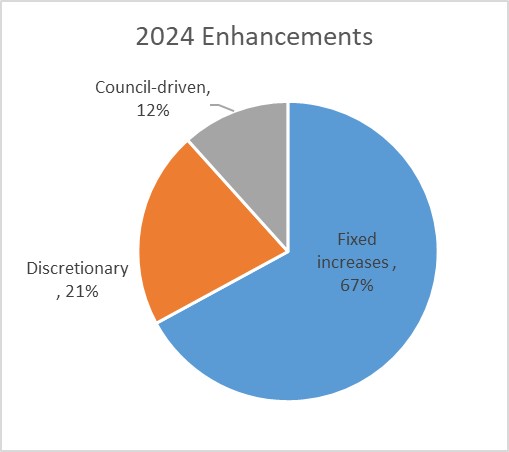 First off, two-thirds of this increase is fixed cost increases, increased costs to deliver the same services we provided in the previous year and things that we are legally or contractually obligated to pay for. About 21% are “discretionary” increases recommended by staff, things we are not legally committed to, but are required to keep service commitments we made to the community. The last 12% are things Council has directed to staff that we want to see happen in the upcoming year. Each of those three can be broken down further:
First off, two-thirds of this increase is fixed cost increases, increased costs to deliver the same services we provided in the previous year and things that we are legally or contractually obligated to pay for. About 21% are “discretionary” increases recommended by staff, things we are not legally committed to, but are required to keep service commitments we made to the community. The last 12% are things Council has directed to staff that we want to see happen in the upcoming year. Each of those three can be broken down further: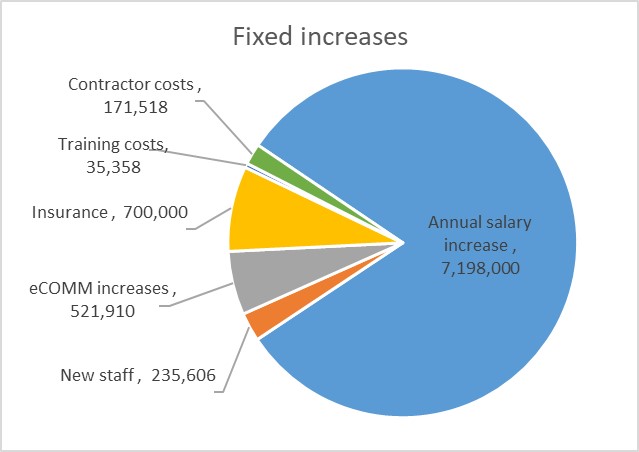

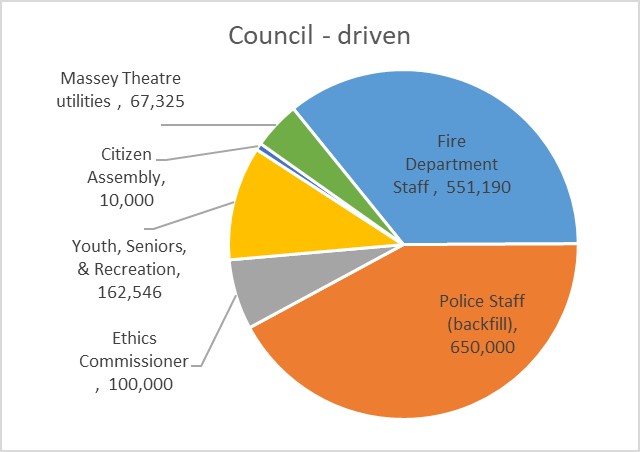 The Council-driven increases are things Council directed to be added to the base budget, mostly in that December workshop. Most of this is in Public Safety, with increased Fire Department staff and new staff for front-line Police to address backfill (that is, we are not increasing the compliment of sworn officers, we are hiring more to provide better coverage for vacancies, sick and parental leave, etc.). Our new Code of Conduct requires budget for an Ethics commissioner, we are augmenting some staff positions to support youth and seniors programming, and the Massey Theatre utility costs are higher than anticipated.
The Council-driven increases are things Council directed to be added to the base budget, mostly in that December workshop. Most of this is in Public Safety, with increased Fire Department staff and new staff for front-line Police to address backfill (that is, we are not increasing the compliment of sworn officers, we are hiring more to provide better coverage for vacancies, sick and parental leave, etc.). Our new Code of Conduct requires budget for an Ethics commissioner, we are augmenting some staff positions to support youth and seniors programming, and the Massey Theatre utility costs are higher than anticipated.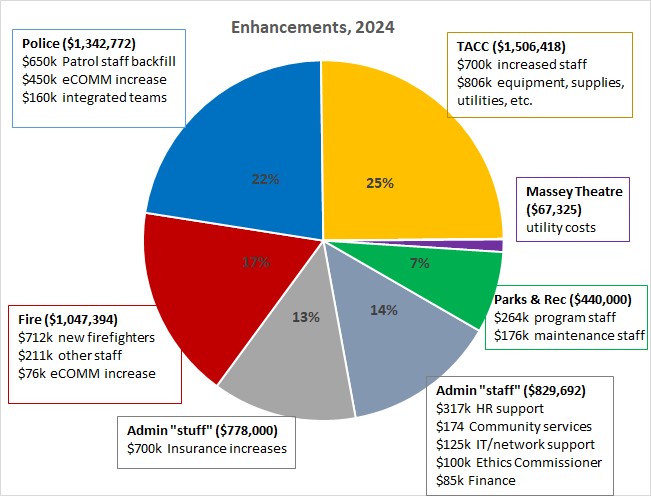
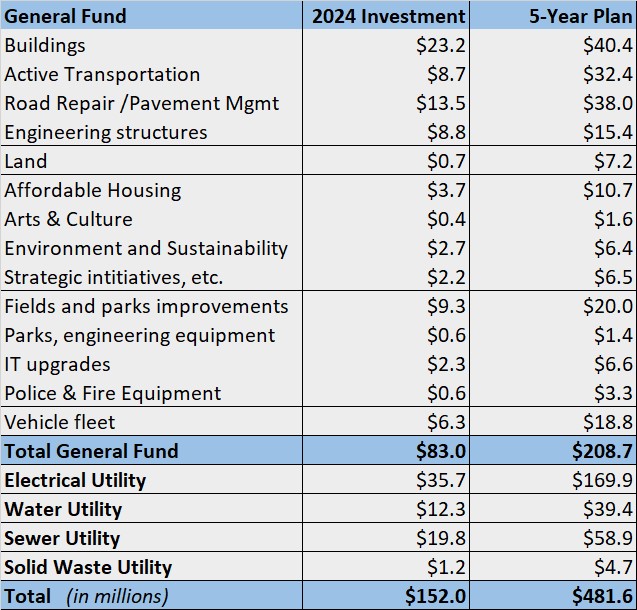
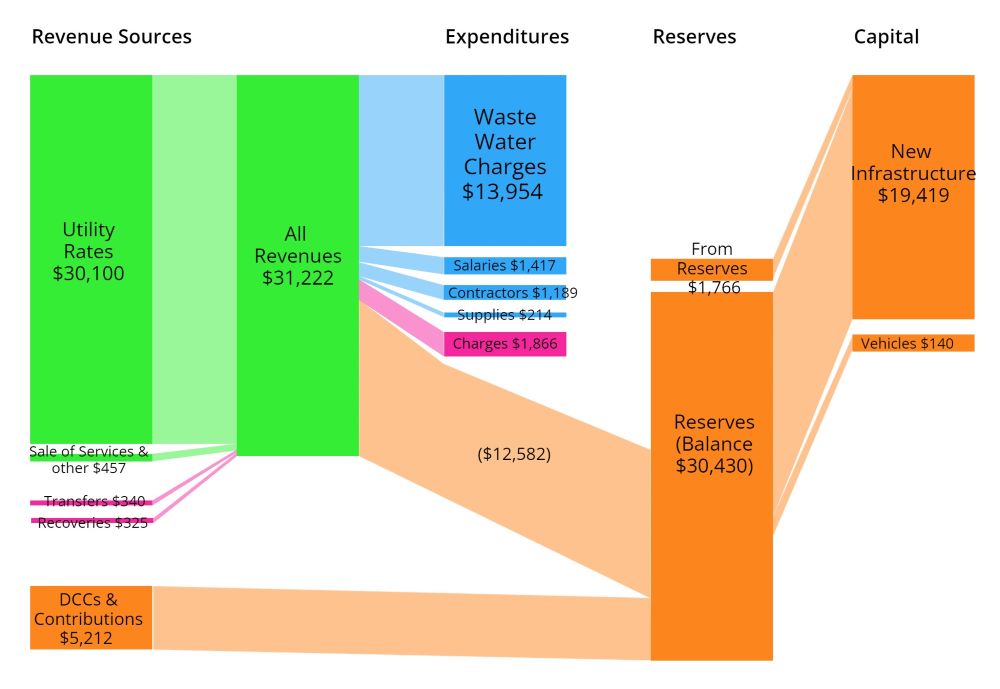
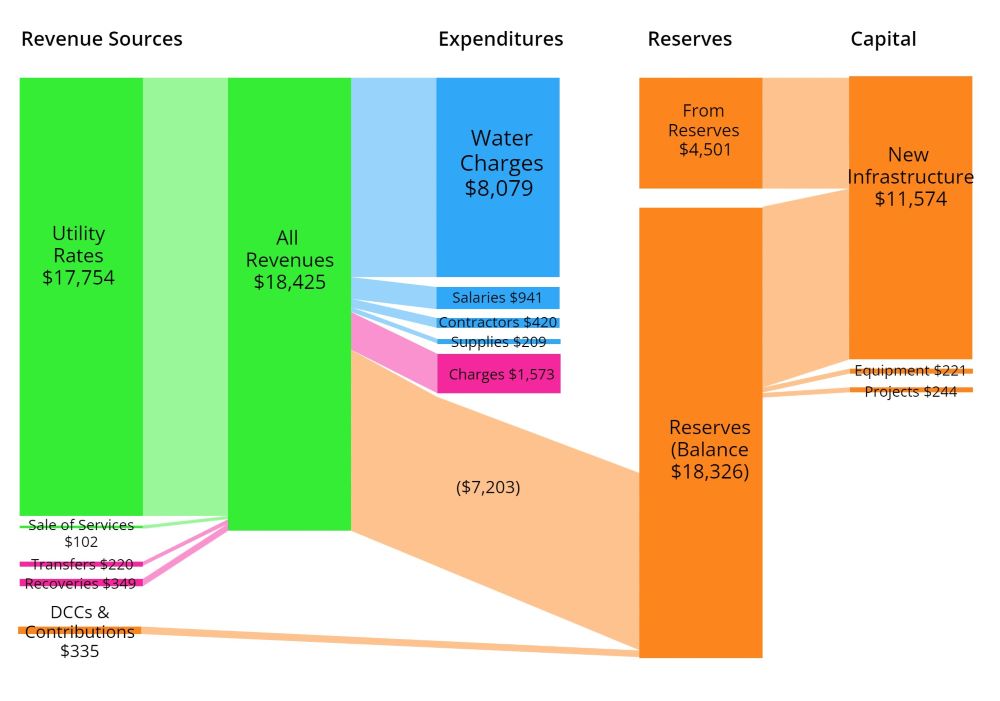 Again, our main source of revenue is utility rates, and the DCC/contribution part is much smaller in water this year. That has mostly to do with the timing of capital projects and our success at getting senior government grants for sewer work more than water work. Of the $18.5 million we take in, about 44% goes directly to Metro Vancouver to pay for the water. We spend less than 10% of our budget on operations, though with internal charges (the money other city departments charge the water utility for services), this cost is a bit higher than in sewers.
Again, our main source of revenue is utility rates, and the DCC/contribution part is much smaller in water this year. That has mostly to do with the timing of capital projects and our success at getting senior government grants for sewer work more than water work. Of the $18.5 million we take in, about 44% goes directly to Metro Vancouver to pay for the water. We spend less than 10% of our budget on operations, though with internal charges (the money other city departments charge the water utility for services), this cost is a bit higher than in sewers.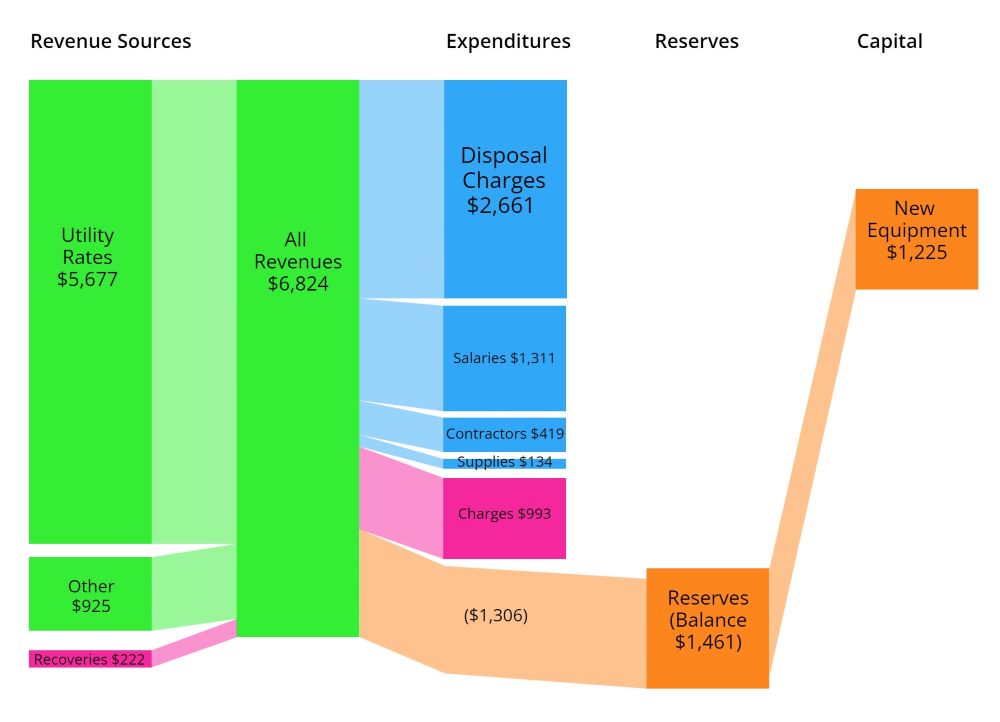 Garbage and recycling are bit different than the other utilities, as the level of service provided to different parts of the community (house vs. strata, home vs. business, etc.) varies quite a bit, and although disposal charges handed down (mostly from Metro Vancouver) for taking in our waste still eat up almost 40% of all of our revenues, there is a much larger operational cost to solid waste. We need staff to drive those trucks and fuel for the trucks, because you can’t put your trash in a pipeline.
Garbage and recycling are bit different than the other utilities, as the level of service provided to different parts of the community (house vs. strata, home vs. business, etc.) varies quite a bit, and although disposal charges handed down (mostly from Metro Vancouver) for taking in our waste still eat up almost 40% of all of our revenues, there is a much larger operational cost to solid waste. We need staff to drive those trucks and fuel for the trucks, because you can’t put your trash in a pipeline.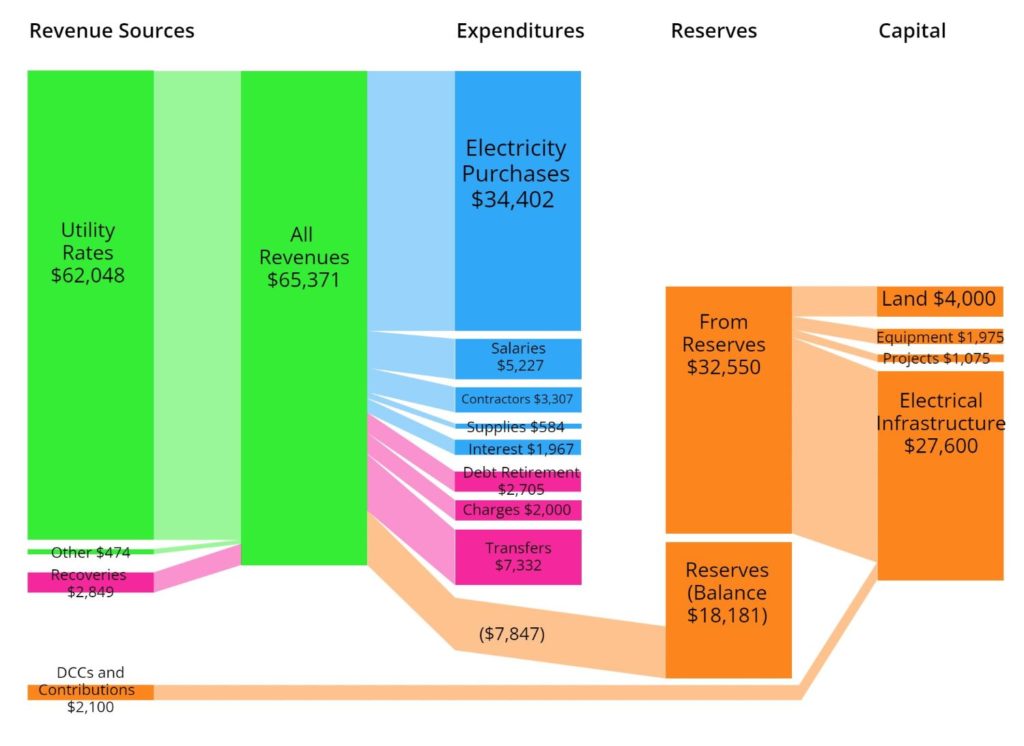 Our Electrical Utility has a few unique aspects, but it functions like the other utilities we have. The electricity we purchase at wholesale from BC Hydro costs us just over half of our overall revenues, and the cost of day-to-day running of the utility costs about another 17% (or a little over $11 million). This leaves us with about a third of income that goes into our Capital Reserves or directly to the City as transfers. The transfer number here is large because it includes the dividend the City takes every year from electrical utility operational surplus and puts it in the general operational fund. This amounts to about $6 million that the City uses to offset property taxes in providing services that we otherwise wouldn’t be able to deliver.
Our Electrical Utility has a few unique aspects, but it functions like the other utilities we have. The electricity we purchase at wholesale from BC Hydro costs us just over half of our overall revenues, and the cost of day-to-day running of the utility costs about another 17% (or a little over $11 million). This leaves us with about a third of income that goes into our Capital Reserves or directly to the City as transfers. The transfer number here is large because it includes the dividend the City takes every year from electrical utility operational surplus and puts it in the general operational fund. This amounts to about $6 million that the City uses to offset property taxes in providing services that we otherwise wouldn’t be able to deliver.